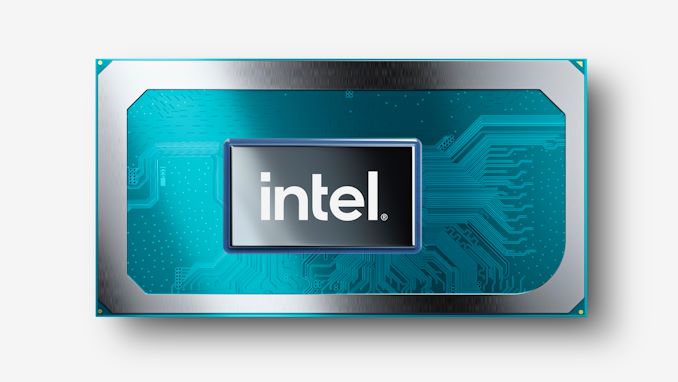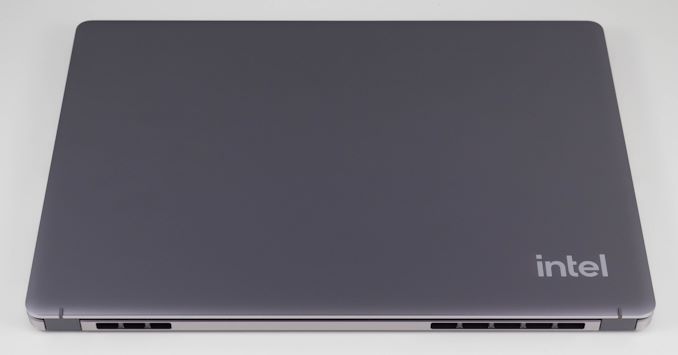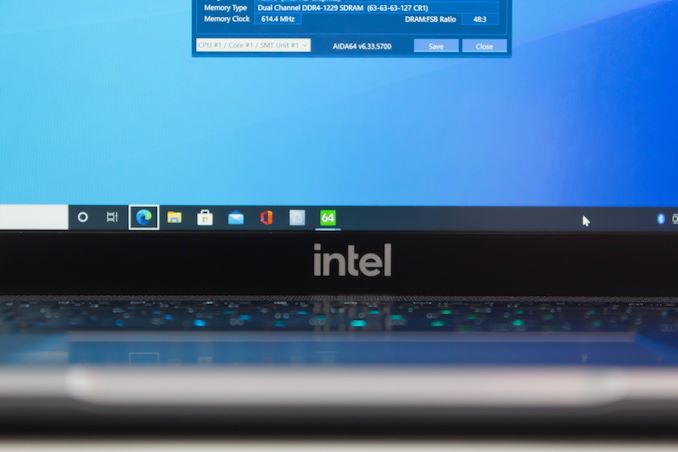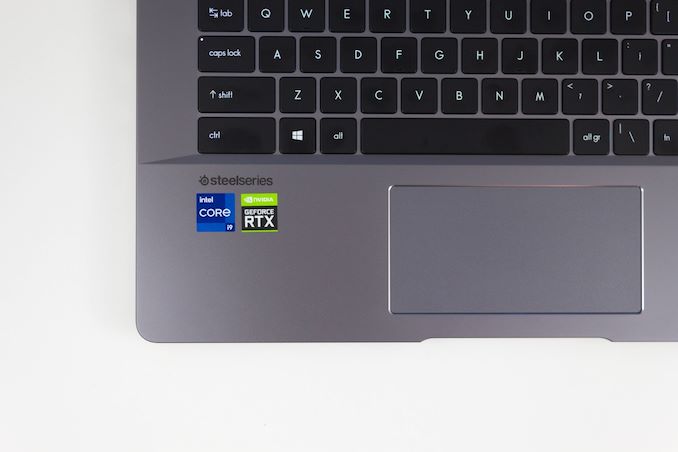Intel 11th Generation Core Tiger Lake-H Performance Review: Fast and Power Hungry
by Brett Howse & Andrei Frumusanu on May 17, 2021 9:00 AM EST- Posted in
- CPUs
- Intel
- 10nm
- Willow Cove
- SuperFin
- 11th Gen
- Tiger Lake-H

Last week Intel launched their Tiger Lake-H family of laptop processors. Aimed at the larger 14-inch and above laptops, this processor family is Intel’s newest offering for the high-performance laptop market, stepping in above Intel’s mobility-focused U and Y series of chips. Based on the same Tiger Lake architecture that we first became familiar with last year, Tiger Lake-H is bigger and better (at least where the CPU is concerned), offering up to 8 CPU cores and other benefits like additional PCIe lanes. Overall, Intel’s H-series chips have long served as the performance backbone of their laptop efforts, and with Tiger Lake-H they are looking to continue that tradition.
While last week was Tiger Lake-H’s official launch, as has become increasingly common for laptop launches, the embargoes for the launch information and for hardware reviews have landed on separate dates. So, while we were able to take about the platform last week, it’s only today that we’re able to share with you our data on TGL-H – and our evaluation on whether it lives up to Intel’s claims as well as how it stacks up to the competition.
Like Intel’s other laptop chips, Tiger Lake-H has multiple facets, with the company needing to balance CPU performance, GPU performance, and power consumption, all while ensuring it’s suitable to manufacture on Intel’s revised 10nm “SuperFin” process. Balancing all of these elements is a challenge in and of itself, never mind the fact that arch-rival AMD is looking to compete with their own Zen 3 architecture-based Ryzen 5000 Mobile (Cezanne) APUs.
| Intel Tiger Lake-H Consumer | ||||||||||
| AnandTech | Cores Threads |
35W Base |
45W Base |
65W Base |
2C Turbo |
4C Turbo |
nT Turbo |
L3 Cache |
Xe GPU |
Xe MHz |
| i9-11980HK | 8C/16T | - | 2.6 | 3.3 | 5.0* | 4.9 | 4.5 | 24 MB | 32 | 1450 |
| i9-11900H | 8C/16T | 2.1 | 2.5 | - | 4.9* | 4.8 | 4.4 | 24 MB | 32 | 1450 |
| i7-11800H | 8C/16T | 1.9 | 2.3 | - | 4.6 | 4.5 | 4.2 | 24 MB | 32 | 1450 |
| i5-11400H | 6C/12T | 2.2 | 2.7 | - | 4.5 | 4.3 | 4.1 | 12 MB | 16 | 1450 |
| i5-11260H | 6C/12T | 2.1 | 2.6 | - | 4.4 | 4.2 | 4.0 | 12 MB | 16 | 1400 |
| *Turbo Boost Max 3.0 | ||||||||||
Intel’s Reference Design Laptop: Core i9-11980HK Inside
For our Tiger Lake-H performance review, Intel has once again sent over one of their reference design laptops. As with the Tiger Lake-U launch last year, these reference design laptops are not retail laptops in and of themselves, but more of an advanced engineering sample designed to demonstrate the performance of the underlying hardware. In this specific case, the BIOS identifies that the laptop was assembled by MSI.
Wanting to put their best foot forward in terms of laptop performance, Intel’s TGL-H reference design laptop is, as you’d imagine, a rather high-end system. The 16-inch laptop is based around Intel’s best TGL-H part, the Core i9-11980HK, which offers 8 Willow Cove architecture CPU cores with SMT, for a total of 16 threads. This processor can turbo as high as 5.0GHz on its favored cores, a bit behind Intel’s previous-generation Comet Lake-H CPUs, but keeping clockspeeds close while making up the difference on IPC.
Unfortunately, their desire to put their best foot forward means that Intel has configured the CPU in this system to run at 65W, rather than the more typical 45W TDP of most high-end laptops. 65W is a valid mode for this chip, so strictly speaking Intel isn’t juicing the chip, but the bulk of the Tiger Lake-H lineup is intended to run at a more lap-friendly 45W. This gives the Intel system an innate advantage in terms of performance, since it has more TDP headroom to play with.
| Intel Reference Design: Tiger Lake-H | |
| CPU | Intel Core i9-11980HK 8 Cores, 16 Threads 2600 MHz Base (45W) 3300 MHz Base (65W) 5000 MHz Turbo 2C 4500 MHz Turbo nT |
| GPU | Integrated: Xe-LP Graphics 32 Execution Units, up to 1450 MHz Discrete: NVIDIA GeForce RTX 3060 Laptop 30 SMs, up to 1703MHz |
| DRAM | 32 GB DDR4-3200 CL22 |
| Storage | 2x OEM Phison E16 512GB SSD (NVMe PCIe 4.0 x4) |
| Display | 16-inch 2560x1600 |
| IO | 2x USB-C 2x USB-A |
| Wi-Fi | Intel AX210 Wi-Fi 6E + BT5.2 Adapter |
| Power Mode | 65 W (Mostly tested at 45W) |
Meanwhile the focus on CPU performance with TGL-H does come at a cost to integrated GPU performance. TGL-H parts include Intel’s Xe-LP GPU, but with only 32 EUs instead of the 96 found on high-end Tiger Lake-U systems. With TGL-H, Intel is expecting these systems to be bundled with discrete GPUs, so they don’t dedicate nearly as much die space to an integrated GPU that may not get used much anyhow. To that end, the reference system comes with an NVIDIA GeForce RTX 3060 Laptop graphics adapter as well, which is paired with its own 6GB of GDDR6.
Rounding out the package, the system comes with 32GB of DDR4-3200 installed. Storage is provided by a pair of Phison E16-based OEM drives, allowing Intel to show off the benefits of PCIe 4.0 connectivity for SSDs. Finally, Wi-Fi connectivity is also Intel-powered, using the company’s new AX210 adapter, which offers Wi-Fi 6E + BT5.2 on a single M.2 adapter. It’s worth noting that the AX210 is a fully discrete adapter, so it doesn’t leverage TGL-H’s integrated (CNVi) MAC, as that doesn’t support Wi-Fi 6E.
And, in keeping with making this reference system look as close to a retail design as reasonably possible, Intel even put the usual Intel Core and NVIDIA GeForce stickers on the laptop.
Unfortunately, we’ve had relatively little time with the system ahead of today’s embargo. The embargo on performance figures was originally scheduled for last Thursday (May 13th). However due to delays in shipping these laptops to reviewers, we didn’t receive the system until the end of last week, and Intel bumped back the embargo accordingly. So with just over two days to look over the system, we’ve really only had a chance to take a look at the most critical aspects of the system when it comes to performance.














229 Comments
View All Comments
Yojimbo - Monday, May 17, 2021 - link
Should read "And frankly, I can't see a good reason for many consumers to be looking at the situation differently such that they would be concerned about the power draw of the laptop when plugged in."I'm not saying that plugged in power usage is useless to consider, just that it seems to me much less important, as far as power-usage is concerned (even for a desktop replacement) than battery-powered power usage and performance. Maybe others feel differently but I don't understand why. It's not like any laptop is a real power hog unlike some desktop systems can be. We're talking about, what, plus-or-minus 20 watts here? 30 watts? 30 watts plugged in means nothing to me. Does it mean a lot to most others, and if so why?
Bik - Monday, May 17, 2021 - link
It's the capability of the laptop to disperse heat. More watt = more heat. The heat is the issue (loud fan, cpu throttle).Yojimbo - Monday, May 17, 2021 - link
But that varies widely from laptop to laptop. And it's not just a function of the heat output, it's a function of the cooling system, which is related to both cost and weight. So you don't really get helpful information for noise or throttling just by looking at plugged-in power usage.vegemeister - Tuesday, May 18, 2021 - link
More power = more noise for the same cost and weight, or more cost and weight for the same noise.repoman27 - Monday, May 17, 2021 - link
Is there a reason why TGL-U is referred to (somewhat confusingly) in the article as just TGL? I know Intel (also somewhat confusingly) uses the TGL-U 4+2 LP die for three separate platforms (UP3, UP4, and H35), but they're all still considered TGL-U, aren't they? Whereas Tiger Lake is the codename for the whole range of processor families including UP3, UP4, H35, and H.Maybe TGL 4+2 and TGL 8+1 would be more succinct?
Andrei Frumusanu - Monday, May 17, 2021 - link
Fair, I'll change the terminology.bernstein - Monday, May 17, 2021 - link
@Andrei Frumusanu :how is it that the amd 5800x (and others) spec2017fp_r results differ by as much as 7 points while the spec2017int_r values are basically on point? (there seem to be minor differences for the 49/4800U in spec2017int_r values too. plus large diff for the i9-10900K).
comparing to : https://www.anandtech.com/show/16252/mac-mini-appl...
Andrei Frumusanu - Monday, May 17, 2021 - link
In that article we were using only the C/C++ sub-benchmarks due to not having a functioning Fortran compiler on the M1 at the time. So it's apples-and-oranges in terms of the scores between the articles. The integer suite only has 1 Fortran workload, the FP suite has much more.Since, I've rerun the M1 ST scores on a vanilla LLVM and Gfortran toolchain to get all workloads, and anyhow all articles except for that initial M1 piece have the full subset of workloads. The M1 MT scores are missing from this piece as I never ran that (brainfart) and no longer have an M1 system at hand.
bernstein - Monday, May 17, 2021 - link
thanks for clearing that up. great articles btw!also thx for anticipating (and answering) my next question!
Ppietra - Monday, May 17, 2021 - link
As far as I know the results in the Mac mini review aren’t the full SPEC 2017, because some tests require a Fortran compiler that didn’t exist for the M1.